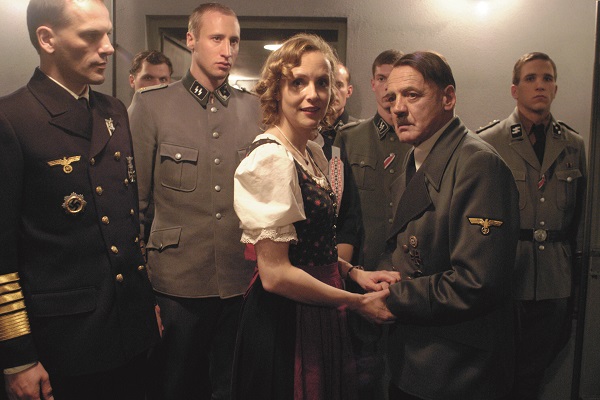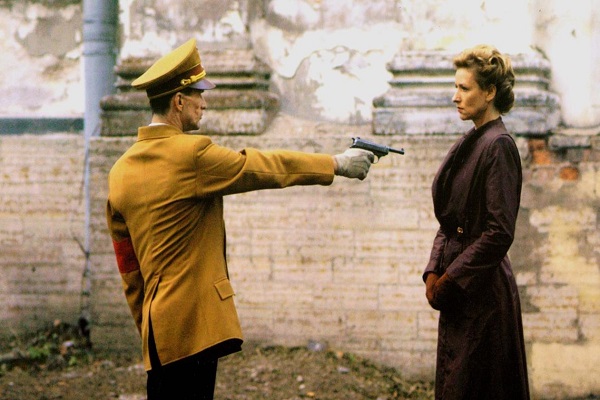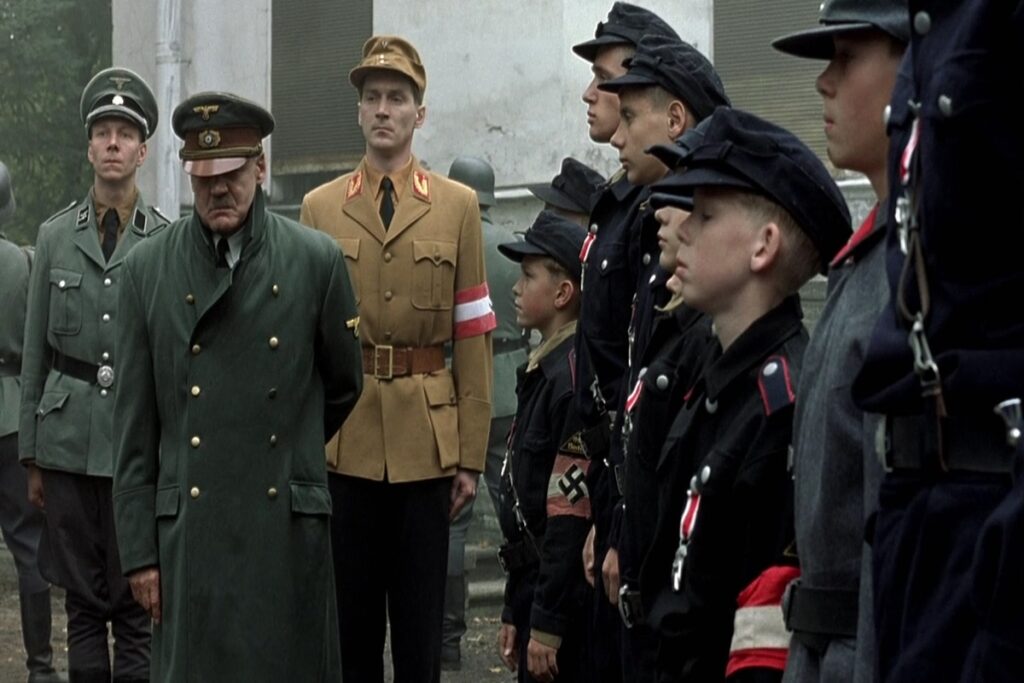A war is a curse to humanity. It does not do any good to anybody. World War II created the worst indelible scar in the history of mankind. More than 70 million lives were massacred. In the name of cultural purification, more than 6 million European Jews were killed in the Holocaust. In addition to the Holocaust victims, millions of other ethnic and minority groups like Poles, Serbs, Slavs, Romanis, and gypsies were also killed. There is a limit to personal ambitions. There is a limit of aggression. When that limit is crossed, the person and the state have the worst downfall, much like Adolf Hitler and Nazi Germany. Downfall shows that the worst atrocities and crimes are committed by humans who belong to this Earth. They don’t descend upon Earth from some far-off planets or stars. They eat, talk, move, and live like normal humans. But behind those apparent normal humans, exist the most brutal monsters ever existed on this planet. In Downfall, filmmaker Oliver Hirschbiegel portrays those human-like monsters.
Downfall starts with an interview process of a group of young women at Wolf’s Lair for the position of Adolf Hitler’s (Bruno Ganz) secretary. He selects Traudl Junge (Alexandra Maria Lara) as his secretary, which makes her jubilant. Then, the film shifts forward to April 1945 when Soviet Red Army is increasingly cornering Nazi German Army. Hitler celebrates his 56th birthday amid heavy firing and shelling on Berlin city center. Reichsfuhrer-SS Heinrich Himmler requests Hitler to start negotiating with the Allies, which he outrightly rejects. Himmler tries to negotiate with the Allies in secret. Gruppenfuhrer-SS Hermann Fegelein tries to convince Hitler to flee from Berlin, which he rejects as well. Even though SS doctor Schenck (Christian Berkel) is ordered to leave Berlin, he chooses to stay back for providing medical treatments to the wounded Nazi soldiers. Hitler Youth member Peter Kranz’s father urges him to leave the fight. Peter refers to his father as a coward.

Despite tremendous attacks and pressure by the Allies from all sides of Berlin, Hitler does not want to surrender. He orders the 9th Army not to retreat. Additionally, he adds Obergruppenfuhrer Felix Steiner’s unit to the counterattack. Peter Kranz is awarded the Iron Cross. Hitler orders armaments minister Albert Speer (Heino Ferch) to implement the Scorched Earth policy. Despite incessant attacks on Berlin city center, Hitler’s partner Eva Braun (Juliane Kohler) throws a party. Her brother-in-law Fegelein advises her to flee from Berlin with Hitler. Hitler promotes General Helmuth Weidling as the commander of the entire Berlin despite his previous order to retreat. Hitler starts ranting in rage when he comes to know that Steiner did not attack because of insufficient forces. Hitler finally acknowledges that the war is lost and blames his generals for the defeat. However, under no circumstances, he is ready to surrender.
German Military summarily executes old citizens who try to flee instead of taking part in resistance. Reichsmarschall Hermann Goring sends a telegram to Hitler asking for Germany’s leadership. His request utterly enrages Hitler who orders his arrest and dismissal from all the duties. Albert Speer meets Hitler at the Fuhrerbunker and admits not carrying out the Scorched Earth policy. However, Hitler does not punish him for disobeying his order. Paul finds out that all of his unit members are dead and rushes back home. Hitler keeps ordering imaginary forces and contemplating irrational strategies to withstand the Soviet attack. While having dinner, he comes to know Himmler’s desperate attempt to negotiate with the Allies, which utterly enrages him again. He orders Himmler’s execution. Despite Eva’s appeal, Fegelein is executed for failing to counterattack. SS doctor Ernst-Robert Grawitz kills himself and his family members when his appeal to leave Berlin is denied.
Red Army continues to march in Berlin. At midnight of 29th April, Hitler dictates his last will to Traudl Junge and then marries his long-time partner Eva Braun. His last hope 12th Army led by Lieutenant General Walther Wenck fails to protect Berlin resisting the Red Army. In the afternoon on 30th April, Hitler kills his beloved dog Blondi by administering potassium cyanide, bids farewell to the remaining members at the Fuhrerbunker, and then commits suicide along with his wife Eva Braun. As per his wish, Nazi soldiers cremate their bodies with petrol at the Reich Chancellory garden.
After Hitler’s suicide, propaganda minister Joseph Goebbels (Ulrich Matthes) becomes the Chancellor of Germany as per Hitler’s last will. He too outrightly rejects the possibility of Germany’s surrender to the Allies. General Hans Crabs fails to negotiate Germany’s conditional surrender with Soviet marshal Georgy Zhukov. On 1st May 1945, Joseph Goebbels’ wife Magda Goebbels kills their six children by administering potassium cyanide, as she could not see any future for her children in Germany without national socialism. Then, the Goebbels commit suicide at the Reich Chancellory garden. Nazi soldiers cremate their bodies with petrol. Commander of Berlin General Helmuth Weidling accepts Nazi Germany’s unconditional surrender to the Allies. Hearing this news, many German soldiers including Hans Crabs commit suicide. Paul comes to know that his parents were executed. In the end, Paul joins Traudl Junge, they walk past the Soviet soldiers and then cycle away from Berlin.

After the release of Downfall, viewers across the world criticized Hirschbiegel for showing the human sides and being sympathetic to the Nazi leaders including Adolf Hitler. However, this is not true. Hirschbiegel did not take their sides at all. The most important point he shows in the film is that all those crimes, violence, atrocities, and human rights violations during World War II were committed by humans. The Nazi leaders including Hitler were humans and did not come from far-off planets. Hitler would love his dog Blondi, affectionately chat and take lunch and dinner with his secretaries, and play with his favorite six children of the Goebbels almost regularly. He referred to Magda Goebbels as the bravest mother in the country. He dictated a country for more than a decade. So, Hitler and his Nazi soldiers did not commit the crimes and massacres in a day. Those were the result of a deeply rooted and well-thought-off organic process that was planned and executed by Hitler and his Nazi soldiers in cold blood for a long period of time. Filmmaker Hirschbiegel vividly and meticulously shows that organic process in Downfall.
Another important point filmmaker Hirschbiegel shows in Downfall is the evil of totalitarian and authoritarian dictatorship. By centralizing the entire power in himself, Adolf Hitler ruled Germany as the Chancellor for over a decade. Nobody had the authority to question him. He was the supreme leader of all three Armies – land, water, and air. He would often reject the suggestions and proposals from other leaders, generals, and ministers. When a country does not have a discussion forum and decisions are not taken based on majority and consensus, it is bound to move in the wrong direction and fail. One person can never have all the abilities to run a nation. When it is totally misdirected, it is not possible to resist its doomsday. That’s what exactly happened to Nazi Germany. The entire country and its citizens had to pay the price for one man’s aggression and stupidity to conquer the entire Europe and subsequently the world. By the time Nazi Germany surrendered, the entire country was turned into debris.
World War II was the worst curse of the world. More than 50 million innocent civilians were killed and countless others were wounded. Limitless aggression and hatred resulted in all those atrocities. However, one question will always remain – why did an entire country support a single person despite being a dictator? There is no denying the fact that Adolf Hitler had a strong influence on his countrymen. There are people who initially attract the masses with their spells and visions and then carry out enormous crimes, violence, and destruction. Hitler was such influential that Magda Goebbels could not see any future for her children in Germany without national socialism and killed them by administering potassium cyanide. People had such a level of obedience to the fuhrer Hitler that their hands did not shiver while murdering their own children. So, quite naturally, Hitler was able to maintain his dictatorship for over a decade. He cast his spell on fellow Germans by showing rapid economic prosperity just after the great depression of the 1930s, which built his tremendous credibility. When he went too far, his fellow citizens had nothing to do but experience the doomsday for the entire nation. Supporting an evil deed only brings evil.
Downfall is an utterly difficult and incredibly well-made film because of its subject and scale. So, when producer Bernd Eichinger offered the film to Oliver Hirschbiegel to direct, it was not an easy decision to make. However, Hirschbiegel went ahead with the film to tell the story honestly. This is the 1st German feature film on this subject. Even though many critics criticized him for showing the human sides of Hitler as well as Nazi soldiers, viewers across the world widely acknowledged that Downfall was a very honest and true attempt and the closest possible film to the real story. This is the 1st WW II film that focused on the Nazi side instead of the Allies. Humongous efforts were put into the research and filming. Bernd Eichinger’s well-researched and detailed screenplay is directly inspired by German historian Joachim Fest’s novel Inside Hitler’s Bunker and Hitler’s secretary Traudl Junge’s memoir Until the Final Hour. His other inspirations include Inside the Third Reich by Albert Speer, Hitler’s Last Days: An Eye-Witness Account by Gerhard Boldt, The Emergency Hospital under the Reich Chancellery by Ernst-Gunther Schenck, and Reflections of a German Soldier by Siegfried Knappe. Eichinger always wanted a film based on Hitler’s final days and the idea of a film project was in his mind for more than two decades. However, it was realized after the publications of Fest’s novel and Junge’s memoirs.
The biggest strength of Downfall is Bruno Ganz’s portrayal of Adolf Hitler. In the film, he looks like an exact replica of Hitler. Ganz prepared for this role for over four months watching thoroughly the Hitler and Mannerheim recording. He dug so deeper into the role that Hitler’s body movements, rants, body language, shaking his left hand, and Austrian dialect came quite naturally to him. Alexandra Maria Lara as Traudl Junge is quite convincing and brings freshness to the screen. Her acting superbly portrays Junge’s admiration and reverence for the fuhrer and his affection for her. However, the real Junge confessed during her interview at the start and end of the film that she committed terrible mistakes as she could not make out the horrendous crimes being committed at that time. The entire cast delivers outstanding performances in Downfall. Corinna Harfouch as Magda Goebbels depicts an outstanding Nazy woman when Hitler refers to her as the bravest mother in Germany. She kills her six children in cold blood by administering potassium cyanide as she could not find any hope for them in Germany without national socialism.
Downfall will be remembered for the authentic portrayal of the Third Reich during its final days. Rainer Klausmann’s documentary-style handheld cinematography realistically captures the devastations during the Battle of Berlin. Klausmann’s camera captures the most intimate moments of Adolf Hitler and his Nazy followers. Viewers get to feel the claustrophobic awful situation at the Fuhrerbunker. In addition to cinematography, Hans Funck’s brilliant editing makes the war scenes look incredibly convincing, dynamic, and overall authentic. Music director Stephan Zacharias’ original soundtracks convey the tension and horror of a great war and the worst curse on mankind. Downfall was filmed in Berlin, Munich, and St. Petersburg, Russia. Production designer Bernd Lepel brilliantly built the Fuhrerbunker on the set in Bavaria studio, Munich. Filmmaker Hirschbiegel used minimum CGI shots in the film. Only the Reich Chancellery was created using CGI as Hirschbiegel felt it would look artificial on the set. Complex war sequences were recreated incredibly skillfully and organically. Overall, Hirschbiegel’s Downfall is an honest and very powerful recreated cinematic writ of Hitler’s as well as Nazi Germany’s downfall in WW II.
